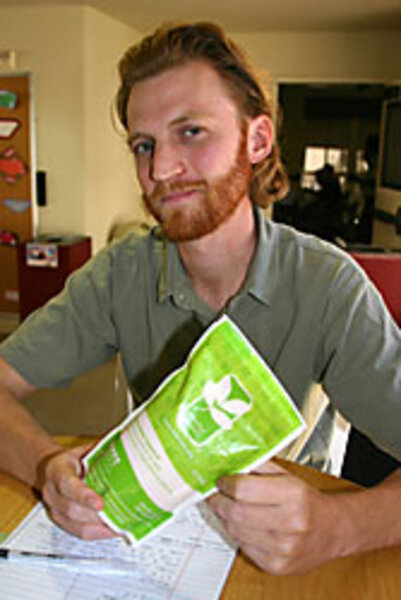Doing well by doing good? It's not easy.
Loading...
| Santa Clara, Calif.
Every entrepreneur here in Silicon Valley has an elevator pitch, a 90-second spiel to lure a potential investor or customer. But few have one like Thomas Stehl's.
He talks about 17-month-old Rosalor, a child in Haiti who arrived at a hospital weighing just 11.9 pounds. She was fed Medika Mamba, a nutrient-packed peanut butter paste made by Mr. Stehl's organization, and in just over a month she gained five pounds and new vitality.
"Rosalor now has a second chance," says Stehl. "There's 120,000 kids just like Rosalor in Haiti. Imagine what's going to happen to the country if they don't [get this] treatment."
While his concern may sound more Sally Struthers than Steve Jobs, Stehl has traveled to Silicon Valley not to solicit donations but to get advice from business experts.
A two-week program at Santa Clara University called the Global Social Benefit Incubator (GSBI) teams up social entrepreneurs like Stehl with Silicon Valley leaders experienced in taking a new idea to mass production.
The program's results reflect the challenges facing nonprofit organizations that adopt business models to serve their social mission. GSBI has graduated some tremendous success stories. But there's also a keen tension between social and business goals, and the difficulty of cracking some developing country markets makes traditional entrepreneurs wince.
"We believe that it's possible to create value in these underserved areas and markets," says James Koch, director of the GSBI. "Large multinational companies have a tremendous myopia to these unmet needs. And they have standard ways of operating ... that would preclude them from the kind of patient, diligent, discovery-based learning that needs to happen."
Social entrepreneurs may need to spend "many, many years," he says, figuring out how to design products and services that work in places like Haiti.
Some past participants of the GSBI program have found that sweet spot. The founders of Thamel.com noticed that 18 percent of Nepal's GDP was coming from remittances, but intermediaries were taking a large cut of that. Their website set up a new way for expatriates to send money back home. Within five years it will be a $100 million social business in revenues, says Mr. Koch.
Another venture named Drishtee, which offers e-health and e-government service across India, successfully scaled up from 1,000 to 10,000 kiosks.
Stehl is the coordinator of operations for Meds & Food For Kids (MFK), which also wants to scale up.
In Haiti, MFK buys peanuts from local farmers, manufactures it into "Medika Mamba," and sells it to healthcare providers there – mainly international NGOs and visiting medical missions. But it wants to make more to bring the cost per unit down.
"A big 'aha' moment for me was hearing Tom [Stehl] say they were at 10 percent of their production capacity. There's this needed food and 90 percent of capacity is not being distributed. And the question is why?" says Michael Looney, one of Stehl's mentors.
Stehl first answered that demand was slowly ratcheting up, but then dived into the challenges. The French firm Nutriset now makes a similar product called Plumpy'nut in the nearby Dominican Republic, selling it at a slightly lower price.
Hearing this, Stehl's other mentor, Brad Mattson asks point blank: "Does anyone really need your product?"
Nutriset's profits leave the Haitian economy, says Stehl. He argues that economic development is a key goal of MFK.
Social entrepreneurs run the risk of figuring out a business model only to see a larger company swoop in with superior resources. It's long been argued that social entrepreneurs make excellent beta testers for corporations, says Nora Silver, director of the Center for Nonprofit and Public Leadership at the University of California Berkeley. "Social entrepreneurs can be closer to the ground ... have more trust," Dr. Silver says, adding that an advantage "they don't have is the money to invest to scale up."
Stehl's mentors speak frankly: Don't expect buyers to pay much extra for "made in Haiti."
Nonprofits are not oblivious to generating revenue. Some data shows that 51 percent of revenue across the nonprofit sector now comes from fees for services. Government and philanthropy make up the rest.
MFK's largely nonprofit customers seem to value social impact in their purchasing decisions. "We are willing to pay a slight premium in price to support a product using local commodities and local production," says Rebecca Heidkamp, a nutritionist with GHESKIO, a nonprofit health organization.
Stehl's mentors, accepting that social mission trumps obvious business logic, brainstorm ways to bring price to parity.
Using Haitian-grown peanuts adds cost because a large portion are infected and must be thrown out. But peanuts aren't the most expensive input – it's dry powdered milk. The mentors propose asking US dairies to donate free milk in exchange for publicity of their support to a worthy cause. That could get price parity long enough to ramp up production.
"Generally social entrepreneurs are passionate about an issue, and they are good at startups," says Silver. "But it's very hard to give birth to a new business while at the same time giving thought to scaling up."





